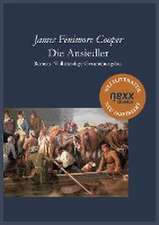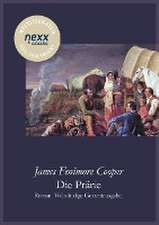The Last of the Mohicans
Autor James Fenimore Cooperen Limba Engleză Paperback – 7 feb 2019
| Toate formatele și edițiile | Preț | Express |
|---|---|---|
| Paperback (46) | 26.79 lei 3-5 săpt. | +8.76 lei 4-10 zile |
| Wordsworth Editions – 30 apr 1992 | 26.79 lei 3-5 săpt. | +8.76 lei 4-10 zile |
| Bantam Books – 31 mai 1982 | 42.06 lei 3-5 săpt. | |
| Penguin Books – 26 noi 1986 | 44.43 lei 24-30 zile | +18.43 lei 4-10 zile |
| UNION SQUARE & CO – feb 2025 | 52.42 lei 3-5 săpt. | +21.35 lei 4-10 zile |
| Alma Books COMMIS – 24 iul 2019 | 52.89 lei 3-5 săpt. | +14.90 lei 4-10 zile |
| Oxford University Press – 11 dec 2008 | 55.28 lei 10-16 zile | +22.63 lei 4-10 zile |
| CREATESPACE – | 58.64 lei 3-5 săpt. | |
| CREATESPACE – | 63.12 lei 3-5 săpt. | |
| CREATESPACE – | 64.04 lei 3-5 săpt. | |
| – | 75.54 lei 3-5 săpt. | |
| CREATESPACE – | 92.14 lei 3-5 săpt. | |
| West Margin Press – 21 oct 2020 | 98.32 lei 3-5 săpt. | |
| CREATESPACE – | 100.45 lei 3-5 săpt. | |
| – | 104.64 lei 3-5 săpt. | |
| CREATESPACE – | 112.41 lei 3-5 săpt. | |
| EMPIRE BOOKS – 31 oct 2011 | 114.66 lei 3-5 săpt. | |
| CREATESPACE – | 118.79 lei 3-5 săpt. | |
| CREATESPACE – | 120.74 lei 3-5 săpt. | |
| CREATESPACE – | 121.86 lei 3-5 săpt. | |
| CreateSpace Independent Publishing Platform – | 127.30 lei 3-5 săpt. | |
| CREATESPACE – | 129.30 lei 3-5 săpt. | |
| BROADVIEW PRESS LTD – 31 ian 2009 | 138.39 lei 3-5 săpt. | +21.48 lei 4-10 zile |
| CREATESPACE – | 142.29 lei 3-5 săpt. | |
| CreateSpace Independent Publishing Platform – | 149.72 lei 3-5 săpt. | |
| – | 160.39 lei 3-5 săpt. | |
| Creative Media Partners, LLC – 23 feb 2012 | 160.51 lei 3-5 săpt. | |
| – | 257.57 lei 3-5 săpt. | |
| CREATESPACE – | 84.54 lei 6-8 săpt. | |
| – | 94.74 lei 6-8 săpt. | |
| CreateSpace Independent Publishing Platform – | 106.35 lei 6-8 săpt. | |
| – | 110.95 lei 6-8 săpt. | |
| Blurb – 7 feb 2019 | 124.40 lei 38-44 zile | |
| SC Active Business Development SRL – 19 oct 2016 | 134.37 lei 38-44 zile | |
| Aegypan Press – 31 ian 2008 | 150.02 lei 38-44 zile | |
| Well Read Edition – 22 ian 2016 | 162.44 lei 6-8 săpt. | |
| SANAGE PUBLISHING HOUSE LLP – 4 apr 2023 | 187.80 lei 6-8 săpt. | |
| Simon & Brown – 31 mai 2011 | 194.82 lei 38-44 zile | |
| Sleeping Cat Press – | 206.97 lei 6-8 săpt. | |
| Simon & Brown – 28 oct 2018 | 215.50 lei 38-44 zile | |
| Simon & Brown – 12 noi 2018 | 223.36 lei 38-44 zile | |
| Simon & Brown – 30 noi 2011 | 223.46 lei 38-44 zile | |
| Simon & Brown – | 223.46 lei 38-44 zile | |
| Echo Library – 30 iul 2003 | 232.62 lei 38-44 zile | |
| VIJ Books – 13 iul 2023 | 258.69 lei 6-8 săpt. | |
| TREDITION CLASSICS – 31 oct 2011 | 263.18 lei 6-8 săpt. | |
| Echo Library – 30 apr 2006 | 274.22 lei 38-44 zile | |
| Hardback (9) | 64.61 lei 3-5 săpt. | +13.10 lei 4-10 zile |
| Classics Illustrated Comics – 27 iul 2016 | 64.61 lei 3-5 săpt. | +13.10 lei 4-10 zile |
| Mint Editions – 6 oct 2020 | 151.77 lei 3-5 săpt. | |
| Simon&Schuster – 3 iun 2013 | 168.86 lei 3-5 săpt. | |
| BENEDICTION CLASSICS – 27 mai 2017 | 166.39 lei 6-8 săpt. | |
| – | 248.65 lei 38-44 zile | |
| Simon & Brown – 28 oct 2018 | 266.54 lei 38-44 zile | |
| – | 276.64 lei 38-44 zile | |
| Simon & Brown – 12 oct 2011 | 277.92 lei 38-44 zile | |
| Simon & Brown – 12 noi 2018 | 283.23 lei 38-44 zile |
Preț: 124.40 lei
Nou
23.81€ • 24.79$ • 20.12£
Carte tipărită la comandă
Livrare economică 06-12 martie
Specificații
ISBN-10: 0368263452
Pagini: 180
Dimensiuni: 203 x 254 x 9 mm
Greutate: 0.37 kg
Editura: Blurb
Textul de pe ultima copertă
The Last of the Mohicans enjoyed tremendous popularity both in America and abroad, offering its readers not only a variation on the immensely popular traditional captivity narrative of the time, but also characters that would become iconic figures in the young nation's emerging literature. The novel's central action follows Leatherstocking and his two faithful friends, Chingachgook and Uncas, as they come to the aid of two daughters of a British officer seeking to become reunited with their father. The novel provides insights into Cooper's own thinking on Native American and White relations during the early national period, revealing a profound ambivalence to the reality that the rising fortunes of the young United States meant the declining fortunes of the nation's Native American inhabitants.
Notă biografică
Cooper became a prolific writer, creating two unique genres that were to become staples in American literature–the sea romance and the frontier adventure story. The first of the famous Leatherstocking tales, The Pioneers, appeared in 1823 and introduced the wilderness scout Natty Bumppo. This detailed portrait of frontier life has been called the first truly American novel. In The Last of the Mohicans (1826) Natty Bumppo becomes the well-loved Hawkeye befriended by the noble Indian Chingachgook; the novel remains a favorite American classic. Other Leatherstocking tales were The Prairie (1827), The Pathfinder (1840) influenced both Herman Melville and Joseph Conrad and led to the use of the sea novel as vehicle for spiritual and moral explorations. Cooper also wrote political satire, romance, and the meticulously researched History of the Navy of the United States of America (1839). By the time of his death on September 14, 1851, he was considered America’s “national novelist.”
Extras
Mine ear is open, and my heart prepared; The worst is worldly loss thou canst unfold:— Say, is my kingdom lost? Richard II, III.ii. 93–95.
It was a feature peculiar to the colonial wars of North America, that the toils and dangers of the wilderness were to be encountered, before the adverse hosts could meet. A wide, and, apparently, an impervious boundary of forests, severed the possessions of the hostile provinces of France and England. The hardy colonist, and the trained European who fought at his side, frequently expended months in struggling against the rapids of the streams, or in effecting the rugged passes of the mountains, in quest of an opportunity to exhibit their courage in a more martial conflict. But, emulating the patience and self-denial of the practised native warriors, they learned to overcome every difficulty; and it would seem, that in time, there was no recess of the woods so dark, nor any secret place so lovely, that it might claim exemption from the inroads of those who had pledged their blood to satiate their vengeance, or to uphold the cold and selfish policy of the distant monarchs of Europe.
Perhaps no district, throughout the wide extent of the intermediate frontiers, can furnish a livelier picture of the cruelty and fierceness of the savage warfare of those periods, than the country which lies between the head waters of the Hudson and the adjacent lakes.
The facilities which nature had there offered to the march of the combatants, were too obvious to be neglected. The lengthened sheet of the Champlain stretched from the frontiers of Canada, deep within the borders of the neighbouring province of New-York, forming a natural passage across half the distance that the French were compelled to master in order to strike their enemies. Near its southern termination, it received the contributions of another lake, whose waters were so limpid, as to have been exclusively selected by the Jesuit missionaries, to perform the typical purification of baptism, and to obtain for it the title of the lake “du Saint Sacrement.” The less zealous English thought they conferred a sufficient honour on its unsullied fountains, when they bestowed the name of their reigning prince, the second of the House of Hanover. The two united to rob the untutored possessors of its wooded scenery of their native right to perpetuate its original appellation of “Horican.”*
Winding its way among countless islands, and imbedded in mountains, the “holy lake” extended a dozen leagues still farther to the south. With the high plain that there interposed itself to the further passage of the water, commenced a portage of as many miles, which conducted the adventurer to the banks of the Hudson, at a point, where, with the usual obstructions of the rapids, or rifts, as they were then termed in the language of the country, the river became navigable to the tide.
While, in the pursuit of their daring plans of annoyance, the restless enterprise of the French even attempted the distant and difficult gorges of the Alleghany, it may easily be imagined that their proverbial acuteness would not overlook the natural advantages of the district we have just described. It became, emphatically, the bloody arena, in which most of the battles for the mastery of the colonies were contested. Forts were erected at the different points that commanded the facilities of the route, and were taken and retaken, rased and rebuilt, as victory alighted on the hostile banners. While the husbandmen shrunk back from the dangerous passes, within the safer boundaries of the more ancient settlements, armies larger than those that had often disposed of the sceptres of the mother countries, were seen to bury themselves in these forests, whence they rarely returned but in skeleton bands, that were haggard with care, or dejected by defeat. Though the arts of peace were unknown to this fatal region, its forests were alive with men; its glades and glens rang with the sounds of martial music, and the echoes of its mountains threw back the laugh, or repeated the wanton cry, of many a gallant and reckless youth, as he hurried by them, in the noontide of his spirits, to slumber in a long night of forgetfulness.
* As each nation of the Indians had either its language or its dialect, they usually gave different names to the same places, though nearly all of their appellations were descriptive of the object. Thus, a literal translation of the name of this beautiful sheet of water, used by the tribe that dwelt on its banks, would be “The tail of the Lake.” Lake George, as it is vulgarly, and now indeed legally, called, forms a sort of tail to Lake Champlain, when viewed on the map. Hence the name. [1831]
It was in this scene of strife and bloodshed, that the incidents we shall attempt to relate occurred, during the third year of the war which England and France last waged, for the possession of a country, that neither was destined to retain.
Recenzii
Descriere
"A rousing frontier saga."-The Washington Post "(Cooper's) sympathy is large, and his humor is as genuine -and as perfectly unaffected-as his art."-Joseph Conrad The Last of the Mohicans (1826) is the most popular of James Fenimore Cooper's Leatherstocking Tales . The continuing adventures of the peerless frontiersman Hawkeye, also known as Natty Bumppo among other monikers, is an unforgettable saga of the frontier life of early America. Set during the French and Indian Wars of mid-eighteenth century, this hair-raising historical novel opens as the French army is attacking Fort William Henry, a British fort in Western New York commanded by the withdrawn Colonel Munro. In the forest between Fort William Henry and another distant British outpost, Munro's daughters Alice and Cora, are escorted through the dangerous terrain by Major Heyward and a Huron Indian named Magua. When the group crosses their path with the white frontiersman Natty Bumppo and his Indian companions, Heyward is warned that they are being betrayed by Magua, and the group is not being led to Fort William Henry. Magua runs to the woods, and the group is lead to safety by Natty and the two remaining members of the Mohican tribe, Chingachgok and his son Uncas. Next morning, the group is attacked by a gang of the Huron tribe, and all are captured with the exception of Natty Bumppo and the mohicans. In the ensuing events of this extraordinary novel, the conflicts of battle, love, and race are unfolded against a thrilling adventure story. This classic of American literature has been adapted into numerous films, including the 1992 version starring Daniel Day-Lewis. With an eye-catching new cover, and professionally typeset manuscript, this edition of The Last of the Mohicans is both modern and readable.





















